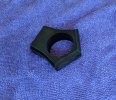I picked up a 2MT to 3/4" Weldon adapter with through coolant feed for my drill press a while back, which lets me use annular cutters. The DP is a British Kerry Super 8 with backgear for low speed operation (54 RPM minimum speed) and copes pretty well with the Annular cutters, though I also have access to a Magnetic drill at work, which copes better.
The cheap Carbide holesaws also work surprisingly well. The "better" ones from Starrett or HMT do seem better than the cheapies off ebay/amazon, but not by a huge margin, IME, on non-blade steels including 316 SS and annealed O1 Ground Flat Stock. They tend to produce a much cleaner hole than bimetal holesaws (again IME). I'd suggest a practice-run, or several, on something cheap before attacking an expensive chunk of blade steel. I've not tried them on anything more exotic than annealed O1, so can't offer specific advice.
A useful method if you have a less-than-optimal drilling setup is to holesaw a hole through a bit of scrap material, then clamp the scrap to the item you actually want the hole in and use the hole in the scrap to guide the cutter with the pilot drill removed. I tend to use this method mostly when I'm on site and can't use a rigid setup, or when I need a disc of something without the pilot hole in the middle. It works with both bimetal and Carbide holesaws. Mostly, I use MDF scrap, but for the Carbide-tooth holesaws a bit of steel is probably better.
Another potentially-useful trick is to drill the pilot hole (usually 1/4") and to fit a bit of drillrod into the holesaw instead of the pilot drill. This tends to limit the amount of wander, particularly with bimetal holesaws. Once these start to chatter and cut not-quite-true, the flutes of the pilot drill can chew into the sides of the pilot hole and enlarge it, allowing the holesaw to wander further. The drillrod can't enlarge the pilot hole, so limits the wander somewhat.

